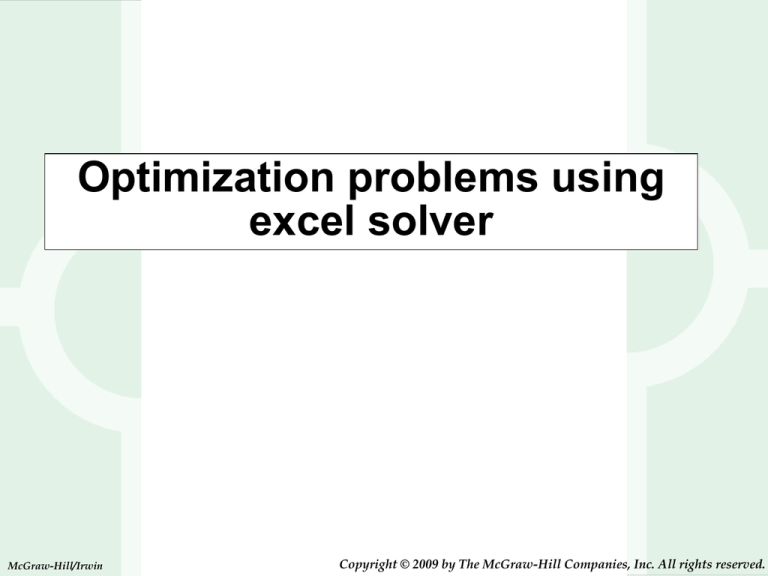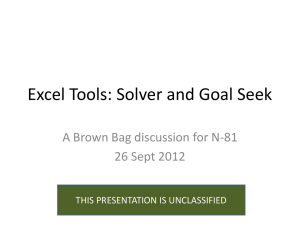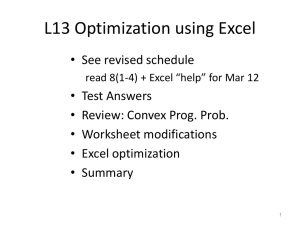
•
Optimization problems using
excel solver
McGraw-Hill/Irwin
Copyright © 2009 by The McGraw-Hill Companies, Inc. All rights reserved.
LAB 3
Linear Programming Using the
Excel Solver
2A-3
OBJECTIVES
• Linear Programming Basics
• A Maximization Problem
• A Minimization Problem
2A-4
Linear Programming Essential Conditions
• Is used in problems where we have
limited resources or constrained
resources that we wish to allocate
• The model must have an explicit
objective (function)
– Generally maximizing profit or
minimizing costs subject to resourcebased, or other, constraints
2A-5
Linear Programming Essential Conditions (Continued)
• Limited Resources to allocate
• Linearity is a requirement of the model
in both objective function and
constraints
• Homogeneity of products produced
(i.e., products must the identical) and
all hours of labor used are assumed
equally productive
• Divisibility assumes products and
resources divisible (i.e., permit
fractional values if need be)
2A-6
Common Applications
•
•
•
•
•
•
•
Aggregate sales and operations planning
Service/manufacturing productivity analysis
Product planning
Product routing
Vehicle/crew scheduling
Process control
Inventory control
2A-7
Objective Function
Maximize (or Minimize) Z = C1X1 + C2X2 + ... + CnXn
• Cj is a constant that describes the
rate of contribution to costs or
profit of (Xj) units being produced
• Z is the total cost or profit from
the given number of units being
produced
2A-8
Constraints
A11X1 + A12X2 + ... + A1nXnB1
A21X1 + A22X2 + ... + A2nXn B2
:
:
AM1X1 + AM2X2 + ... + AMnXn=BM
• Aij are resource requirements for each of
the related (Xj) decision variables
• Bi are the available resource
requirements
• Note that the direction of the inequalities
can be all or a combination of , , or =
linear mathematical expressions
2A-9
Non-Negativity Requirement
X1,X2, …, Xn 0
• All linear programming model
formulations require their decision
variables to be non-negative
• While these non-negativity
requirements take the form of a
constraint, they are considered a
mathematical requirement to
complete the formulation of an LP
model
2A-10
Excel solver
• The Excel Solver is a tool for solving linear
and nonlinear optimization problems.
– For linear optimization problems: Simplex method,
with branch and bound algorithm for integer
design variables.
– For nonlinear optimization problems: Generalized
reduced gradient method.
• Solver is an Add-In for Microsoft Excel
which can solve optimization problems,
including multiple constraint problems.
• Launching the Excel Solver:
Start the Excel program.
Tools > Solver…
2A-11
Installing Excel solver
• On Excel Menu,
choose
– Tools
• Add-Ins...
– Put a Check
in the Box Next
to ‘Solver Add-in’
2A-12
Using Excel solver
• On Excel Menu,
choose
– Tools
• Solver
– This brings
up the Solver
Parameters
box which
will be
discussed next.
2A-13
Excel solver
2A-14
Excel solver
Using the Excel Solver: (…continued)
Add: (adding a new constraint)
Cell Reference:
Address of design variable.
Choose type of constraint:
or = or or int (integer) or bin (binary).
Constraint:
Value of constraint (if applicable).
Options:
Assume Non-Negative (if all design variables are nonnegative) > OK.
OK or Add (to add another constraint)
2A-15
An Example of a Maximization Problem
LawnGrow Manufacturing Company must determine the unit
mix of its commercial riding mower products to be
produced next year. The company produces two product
lines, the Max and the Multimax. The average profit is $400
for each Max and $800 for each Multimax. Fabrication hours
and assembly hours are limited resources. There is a
maximum of 5,000 hours of fabrication capacity available
per month (each Max requires 3 hours and each Multimax
requires 5 hours). There is a maximum of 3,000 hours of
assembly capacity available per month (each Max requires 1
hour and each Multimax requires 4 hours). Question: How
many units of each riding mower should be produced each
month in order to maximize profit?
Now let’s formula this problem as an LP model…
2A-16
The Objective Function
If we define the Max and Multimax products as the two
decision variables X1 and X2, and since we want to
maximize profit, we can state the objective function as
follows:
Maximize Z = 400X1 + 800 X 2
Where
Z = the monthly profit from Max and Multimax
X1 = the number of Max produced each month
X 2 = the number of Multimax produced each month
2A-17
Constraints
Given the resource information below from the problem:
Max (X1)
Required Time/Unit
3
1
Multimax (X2)
Required Time/Unit
5
4
Available Time/Month
5,000
3,000
Fab
Assy
We can now state the constraints and non-negativity
requirements as:
3X1 + 5X2 5,000
(Fab.)
X1 + 4X2 3,000
(Assy.)
X1 , X 2
0
(Non- negativity)
Note that the inequalities are less-than-or-equal since
the time resources represent the total available
resources for production
2A-18
Solution
Produce 715 Max and 571 Multimax per
month
for a profit of $742,800
2A-19
The Excel Solver Formulation
2A-20
An Example of a Minimization Problem
HiTech Metal Company is developing a plan for buying
scrap metal for its operations. HiTech receives scrap
metal from two sources, Hasbeen Industries and
Gentro Scrap in daily shipments using large trucks.
Each truckload of scrap from Hasbeen yields 1.5 tons
of zinc and 1 ton of lead at a cost of $15,000. Each
truckload of scrap from Gentro yields 1 ton of zinc and
3 tons of lead at a cost of $18,000. HiTech requires at
least 6 tons of zinc and at least 10 tons of lead per day.
Question: How many truckloads of scrap should be
purchased per day from each source in order to
minimize scrap metal costs to HiTech?
Now let’s formula this problem as an LP model…
2A-21
The Objective Function
If we define the Has been truckloads and the Gentro
truckloads as the two decision variables X1 and X2, and
since we want to minimize cost, we can state the
objective function as follows:
Minimize Z = 15,000 X1 + 18,000 X2
Where
Z=
daily scrap cost
X1 = truckloads from Hasbeen
X2 = truckloads from Gentro
Hasbeen
Gentro
2A-22
Constraints
Given the demand information below from the problem:
Hasbeen (X1)
Tons
1.5
1
Gentro (X2)
Tons
1
3
Min Tons
6
10
Zinc
Lead
We can now state the constraints and non-negativity
requirements as:
1.5X1 +
X2
> 6(Zinc/tons)
X1
3X2
> 10(Lead/tons)
+
X1, X2
> 0(Non-negativity)
Note that the
inequalities are
greater-than-orequal since the
demand information
represents the
minimum necessary
for production.
2A-23
Solution
Order 2.29 truckloads from Hasbeen and 2.57
truckloads from Gentro for daily delivery. The daily
cost will be $80,610.
Note: Do you see why in this solution that
“integer” linear programming methodologies
can have useful applications in industry?
2A-24
The Excel Solver solution
2A-25
Question
Find x1, x2, x3, x4, y1, y2, y3, y4 to
maximize
f = 10x1+ 6.5x2+ 6x3+ 5x4 2y1+
5.5y2+ 5y3+ 4y4
subject to
x1+ y1 = 25
x2+ y2 = 45
x3+ y3 = 50
x4+ y4 = 60
x1+ x2+ x3+ x4 50
y1+ y2+ y3+ y4 1000
x1, x2, x3, x4, y1, y2, y3, y4 0.
2A-26
Answer
Using the Excel Solver:
Design variables:
A1 = x1, A2 = x2, A3 = x3, A4 = x4
B1 = y1, B2 = y2, B3 = y3, B4 = y4
Objective function:
C1 =
10*A1+6.5*A2+6*A3+5*A42*B1+5.5*B2+5*B3
+4*B4
Constraints:
D1 = A1+B1, D2 = A2+B2,
D3 = A3+B3,
D4 = A4+B4
D5 = A1+A2+A3+A4, D6 = B1+B2+B3+B4
2A-27
Answer
• (…continued)
Set Target Cell: C1
Equal To: Max
By Changing Cells: A1 to B4
Subject to the Constraints: Add
D1 = 25
Add
D2 = 45
Add
D3 = 50
Add
D4 = 60
Add
D5 <= 50
Add
D6 <= 1000
OK
Options > Assume Non-Negative > OK
Solve
Keep Solver Solution > OK
2A-28
Answer
• (…continued)
Solutions in A1 to A4 and B1 to B4:
(x1, x2, x3, x4) = (25, 0, 10, 15)
(y1, y2, y3, y4) = (0, 45, 40, 45)
Maximum profit in C1 = 1012.5
Note that the solution is not unique. Verify that
another solution is given by
(x1, x2, x3, x4) = (25, 0, 0, 25)
(y1, y2, y3, y4) = (0, 45, 50, 35)
2A-29
End












